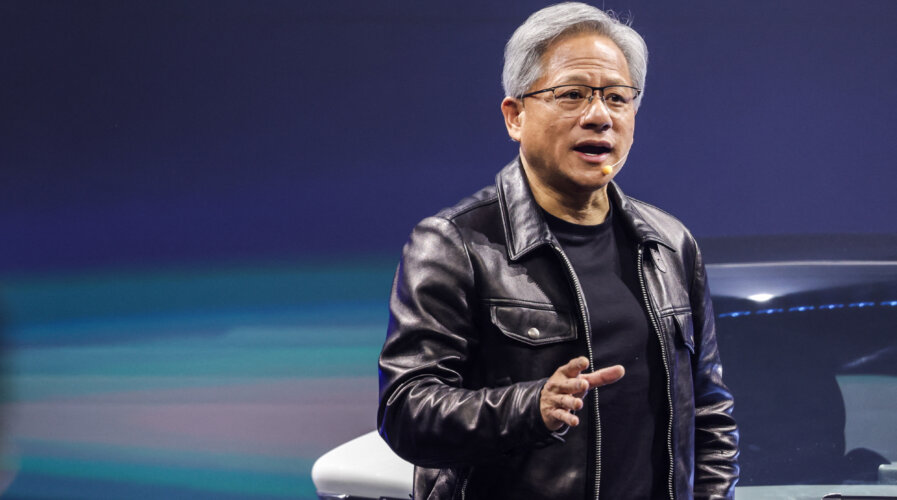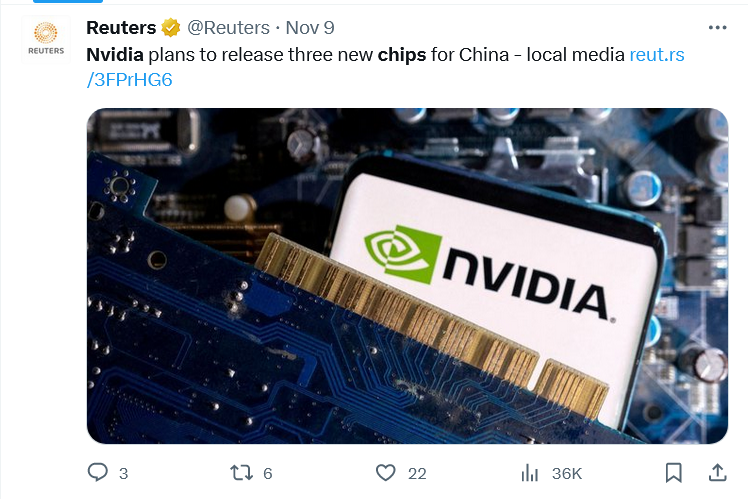
Nvidia is anticipated to launch AI chips tailored for China, responding swiftly to recent US restrictions on high-end chip sales to the Chinese market. (Photo by I-Hwa Cheng / AFP)
Nvidia has three more AI chips for China, circumventing US bans again
- Nvidia is expected to launch AI chips tailored for China, responding swiftly to recent US restrictions.
- The HGX H20, L20 PCIe, and L2 PCIe are the names of the Nvidia chips.
- An official announcement from Nvidia could come as early as next week.
When the US Commerce Department first imposed restrictions on companies, stopping them from supplying advanced chips and chipmaking equipment to China in October 2022, it impacted Nvidia’s A100 and H100 chips. But it didn’t take long before Nvidia unveiled the A800, a pared-down version of the A100, as a workaround for export restrictions. Subsequently, in March 2023, Nvidia introduced the H800 as a substitute for the banned H100 chips, aligning its performance with the criteria set by the Commerce Department.

Anyone who’s read Romeo and Juliet knows you can’t ban your way to success. Nvidia (Juliet) is finding ways to see her Chinese Romeo.
For the US, the goal is simple: to curb China’s ability to produce cutting-edge chips for weapons and other defense technology. So, in an anticipated move, the US came up with fresh regulations in October this year, promptly limiting the export of both the A800 and H800 chips tailored for China. Nvidia’s initial strategy of an additional 30 days to fulfill more orders was rendered obsolete.
But Nvidia is determined to maintain its supply for China. After all, China’s revenue share of Nvidia’s data center business is around 20-25%, which grew 171% year-over-year last quarter, generating more than US$10 billion. The demand for Nvidia’s chip is too prominent to be ignored. So much so that the cost of an Nvidia AI chip on the underground market in China this past June had hit US$20,000, double the retail price.
China’s most prominent internet players alone—Alibaba, Baidu, ByteDance, and Tencent—spent a staggering US$1 billion to buy around 100,000 of Nvidia’s A800 processors in August. This means that Nvidia will not forgo China’s demand easily, so it decided to work on three newer chips to circumvent the US’ latest export ban.
“When the US dropped updated AI restrictions, we thought the US locked down every single loophole conceivable. To our surprise, Nvidia still found a way to ship high-performance GPUs into China with their upcoming H20, L20, and L2 GPUs,” the chip industry newsletter SemiAnalysis explained, breaking the news to the public. In the newsletter, SemiAnalysis also shared that Nvidia has product samples for these newer GPUs, which will go into mass production within the next month.

The detailed specs include FLOPS figures, NVLink bandwidth, power consumption, memory bandwidth, memory capacity, die size, and more. The simple specs are on this table. Source: SemiAnalysis
“Yet again, Nvidia is showing its supply chain mastery,” Dylan Patel, chief analyst at SemiAnalysis, wrote. But Nvidia did experience its most significant stock decline in months when the Biden administration intensified efforts in October. The company also cautioned that its product development and customer supply capabilities could be impacted due to the recent restrictions.
Under the new US export control regulations, Nvidia cannot ship its flagship consumer gaming graphic card, the RTX 4090, to China, the world’s largest semiconductor market. Although Nvidia said that it doesn’t anticipate an immediate financial impact from the recent restrictions, reports indicate the possibility of canceling orders worth billions of dollars from Chinese tech firms.
Latest AI chips by Nvidia for China and possible implications
According to Patel, one of the China-specific GPUs is over 20% faster than the H100 in LLM inference and is more similar to the new GPU that Nvidia is launching early next year than to the H100. Spec details on Nvidia’s new GPUs show that the AI chip giant is “perfectly straddling the line on peak performance and performance density with these new chips to get them through the new US regulations,” he added.
According to a report by Reuters quoting a note by Wells Fargo analyst Aaron Rakers, all three of Nvidia’s reported chips appear to fall below the absolute caps on computing power, though one seems to be in the gray zone and will require a license.
Rakers believes that while the introduction of these three new GPUs is positive, “we would expect investors to question whether [Nvidia] is being a bit too aggressive in its efforts to circumvent US restrictions and could ultimately just result in further [US government] moves going forward,” Rakers wrote, noting that Nvidia gets around a quarter of its data center chip revenue from China.
READ MORE
- Safer Automation: How Sophic and Firmus Succeeded in Malaysia with MDEC’s Support
- Privilege granted, not gained: Intelligent authorization for enhanced infrastructure productivity
- Low-Code produces the Proof-of-Possibilities
- New Wearables Enable Staff to Work Faster and Safer
- Experts weigh in on Oracle’s departure from adland




